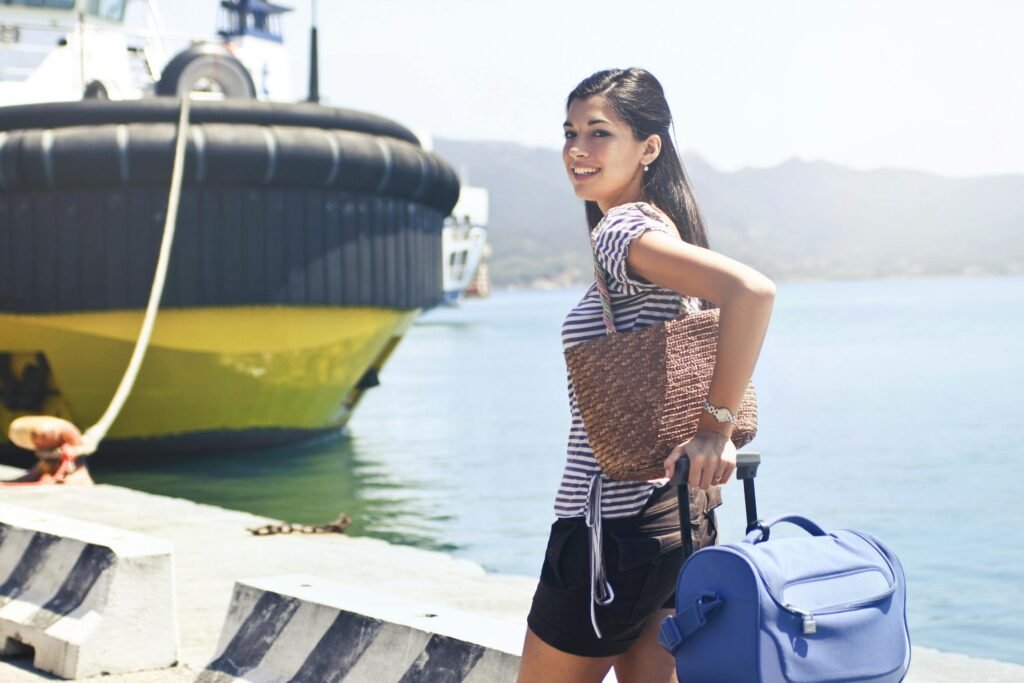Picture this: you’re standing in front of the Colosseum, sweat dripping down your back, desperately wishing you’d packed differently for your Italian summer vacation.
Italy in July can reach temperatures of 85-95°F (29-35°C), with humidity that’ll make you question every clothing choice you’ve ever made.
But here’s the thing – Italians are effortlessly chic even in scorching heat, and after several summer trips to the boot-shaped peninsula, I’ve cracked the code on looking stylish while staying cool.
Whether you’re planning to explore the cobblestone streets of Rome, admire Renaissance art in Florence, or soak up the sun on the Amalfi Coast, this guide will help you pack smart and dress like a local.
If you are thinking How to Dress for Italy in July, then this article for you.
Essential Fabrics for Italian Summer Heat
The Breathable Basics You Need
Man, did I learn this the hard way! On my second day in Rome, I was walking around in a polyester blend top that basically turned me into a human sauna.
Linen is your best friend in Italy. It’s lightweight, breathable, and has that effortless European vibe that screams “I belong here.” The wrinkles? They’re part of the charm! Italians don’t stress about perfectly pressed linen – it’s supposed to look lived-in.
Cotton is another lifesaver, especially lightweight cotton blends. I always pack a few cotton button-downs that can work for both day exploring and evening dinners. The key is choosing loose-fitting cuts that allow air to circulate.
Fabrics to Avoid at All Costs
Learn from my mistakes – synthetic fabrics are the enemy of Italian summers. Polyester, nylon, and heavy blends will have you sweating through your clothes before you even reach the Trevi Fountain.
Avoid heavy denim too. I packed thick jeans thinking they’d be versatile, but they became unwearable after 10 AM. If you must bring denim, opt for lightweight, stretch versions.
Women’s Outfit Ideas for Different Italian Destinations

Rome: Urban Chic Meets Ancient History
Walking through Rome in July feels like stepping into a beautiful, historical oven. The city’s cobblestones absorb heat all day and radiate it back at you.
My go-to Rome outfit: A flowy midi dress in linen or cotton, comfortable walking sandals with good arch support, and a lightweight cardigan for air-conditioned museums. Don’t forget a wide-brimmed hat – the sun reflects off those ancient stones like nobody’s business!
For Vatican visits, remember the dress code requires covered shoulders and knees. I learned this the hard way when I showed up in a sundress and had to buy an overpriced scarf from a street vendor. Pack a lightweight scarf or shawl that you can easily throw on.
Florence: Renaissance Elegance
Florence is slightly more conservative than Rome, and the locals dress with understated elegance. The city’s narrow streets provide some shade, but those hills will get your heart pumping.
Perfect Florence look: Linen palazzo pants paired with a sleeveless blouse, comfortable leather sandals, and a crossbody bag. The palazzo pants keep you cool while looking polished enough for those fancy leather markets.
I always pack a lightweight blazer for nicer restaurants. Italians dress up for dinner, even in summer, and you’ll feel out of place in overly casual clothes at upscale establishments.
Coastal Areas: Beach Towns and Amalfi Coast
The coastal regions have that gorgeous Mediterranean breeze, but the sun is intense, especially reflecting off the water.
Beach town essentials: Flowy maxi dresses that transition from beach to dinner, comfortable wedge sandals for those steep coastal paths, and always, always a good sun hat. I made the mistake of forgetting sunglasses on my first Amalfi hiking trip – squinting through Positano is not a good look!
Cover-ups are essential for moving between beach and town. A lightweight kimono or sarong works perfectly and adds that effortless beachy vibe.
Men’s Style Guide for Italian Summer

The Italian Man’s Summer Uniform
Italian men have mastered the art of looking put-together in extreme heat. Their secret? Quality basics in natural fabrics with impeccable fit.
The foundation: Lightweight cotton or linen shirts in white, light blue, or subtle patterns. Always, and I mean always, go for a proper fit. Baggy clothes might seem cooler, but they actually trap heat and look sloppy.
Chino shorts or lightweight trousers are your best bet. I see too many tourists in athletic shorts and flip-flops, which scream “I’m not from here.” Italians rarely wear athletic wear outside of actual sports activities.
Footwear That Won’t Fail You
This is where many guys go wrong. Sneakers can work, but choose leather or canvas options in neutral colors. I’ve worn my white leather sneakers through countless Italian summers – they’re comfortable, breathable, and stylish.
Avoid: Chunky athletic shoes, flip-flops for city exploration, and anything with excessive branding. Italian style is about subtlety and quality over flashy logos.
For dressier occasions, loafers or leather sandals work well. Just make sure they’re broken in before your trip – new shoes and cobblestone streets are a recipe for disaster!
Footwear Essentials for Italian Cobblestones
The Shoe Situation is Real
Let me tell you about my first Italian shoe disaster. I packed cute ballet flats thinking they’d be perfect for sightseeing. Three hours into my first day in Florence, I had blisters that made walking torture.
Italian cobblestones are beautiful but brutal. They’re uneven, slippery when wet, and unforgiving on thin-soled shoes. You need footwear with good support and sturdy soles.
What Actually Works
For women: Comfortable walking sandals with ankle support, low-heel wedges for dressier occasions, and breathable sneakers for extensive walking days. I swear by my leather walking sandals – they’ve carried me through Rome, Florence, and the Amalfi Coast without a single blister.
For men: Leather sneakers, boat shoes, or comfortable loafers. The key is good arch support and sturdy construction. Canvas shoes can work but tend to wear out quickly on rough surfaces.
The Backup Plan
Always pack blister patches and foot powder. Even the best shoes can cause problems when you’re walking 15,000+ steps a day in heat. I learned to put foot powder in my shoes every morning – it prevents moisture buildup and keeps your feet happier.
Accessories That Make the Difference
Sun Protection is Non-Negotiable
The Mediterranean sun is no joke. I’ve seen tourists turn lobster-red on their first day because they underestimated the intensity.
Must-have accessories: A wide-brimmed hat, quality sunglasses, and a lightweight scarf for shoulders. The scarf serves double duty – sun protection and meeting dress codes at religious sites.
The Bag Situation
Choose a crossbody bag or small backpack that sits close to your body. Rome and Florence have pickpocket issues, and tourists with obvious camera bags are easy targets.
I prefer a leather crossbody that looks stylish but keeps my hands free for gelato! Make sure it has a secure zipper and consider one with RFID protection for your cards.
Dressing for Different Activities

Museum Hopping
Italian museums are often air-conditioned, which sounds great until you realize the temperature difference can be shocking. I always bring a lightweight cardigan or wrap for indoor spaces.
Pro tip: Layers are your friend. A light top with a cardigan that you can easily remove and carry works perfectly. Comfortable closed-toe shoes are essential – you’ll be standing and walking on hard floors for hours.
Evening Dining
Italians dress up for dinner, even in summer. This doesn’t mean formal wear, but it does mean putting in some effort.
For women: A nice dress or dressy pants with a blouse works well. Add simple jewelry and comfortable dressy sandals. Avoid flip-flops and overly casual clothes.
For men: Long pants (even in heat – trust me on this), a collared shirt, and proper shoes. You can wear lighter colors and fabrics, but the silhouette should be polished.
Day Trips and Excursions
Whether you’re visiting Tuscan vineyards or exploring coastal towns, comfort is key, but you still want to look presentable.
Pack comfortable walking shoes, a hat, and layers. A light sweater or jacket is useful for air-conditioned buses or unexpected weather. Water-resistant items are smart for coastal areas where sea spray is common.
Packing List and Final Tips
Here’s what I always pack for Italian summers:
Clothing:
- 3-4 lightweight dresses or shirt/pant combinations
- 1-2 cardigans or light sweaters
- Comfortable walking shoes
- Dressy sandals or shoes
- Sleepwear in breathable fabrics
- Light jacket or blazer for evenings



